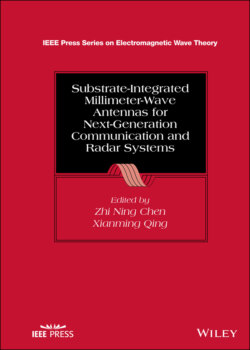Читать книгу Substrate-Integrated Millimeter-Wave Antennas for Next-Generation Communication and Radar Systems - Группа авторов - Страница 29
1.8 Update of Millimeter Wave Technology in 5G NR and Beyond
ОглавлениеRecently mmW has attracted much attention of the industry although it is not a new technology. In particular, the mobile communication networks are significantly increasing their capacity by increasing the usage efficiency of existing spectra such as massive multiple‐input‐multiple‐output (massive MIMO), the number of small cell base stations, and the operating bandwidth by extending operating frequencies from sub‐6 GHz bands to mmW bands to enhance the peak data rates of mobile broadband use case up to 20 Gbps in the downlink (DL) and 10 Gbps in the uplink (UL). With such high data rates, many new applications such as high‐speed streaming of 4K or 8K UHD movies and self‐driving cars will be supported.
According to the release of specifications by The 3rd Generation Partnership Project (3GPP), a standards organization developing the protocols for mobile telephony, the following bands as tabulated in Table 1.5 [53] have been defined for fifth‐generation (5G) new radio (NR) networks. The allocated bandwidths reach up to 3 GHz each while the total frequency ranges from 24.25 to 40.00 GHz.
Table 1.6 compares the features of mobile communication network operating at 5G NR sub‐6 GHz and mmW bands. Not surprisingly, the systems operating at mmW bands suffer from the higher path‐loss and blocking due to weaker refraction and reflection in propagation in denser environments.
Based on the previous analysis and initial feedback from field trials, the mmW in 5G NR networks will have the typical applications as shown in Figure 1.11. It is estimated that for 5G NR the mmW systems can be used with the similar scenarios at sub‐6 GHz bands, but coverage will be significantly reduced due to the higher path‐loss and blocking of mmW propagation. The higher path‐loss is caused by the reduced physical aperture of receive antennas with the same gain as the antennas operating at lower frequencies. Therefore, the electrical apertures or gain of the mmW antennas should be increased to keep the gain unchanged or link budget compared with the antennas operating at lower frequencies.
Table 1.5 mmW frequency ranges for 5G NR (TDD).
| NR operating band | FUL/DL_low – FUL/DL_high |
|---|---|
| n257 | 26.50–29.50 GHz |
| n258 | 24.25–27.50 GHz |
| n260 | 37.00–40.00 GHz |
Duplex Mode: Time‐division duplexing (TDD)
Uplink (UL): base station (BS) receive and user equipment (UE) transmit
Downlink (DL): base station (BS) transmit and user equipment (UE) receive.
Table 1.6 Comparison of features of network at 5G NR sub‐6 GHz and mmW bands.
| Sub‐6 GHz | mmW | |
|---|---|---|
| Bandwidth | ∼100 MHz | 500 MHz @28 GHz/>2 GHz @E‐band |
| BS/UE antenna configuration | Single/sectorized arrays | Very high‐gain directional arrays |
| Network deployment | Low base‐station density | Very high base‐station density |
| Small‐scale fading | Correlated with high rank | Correlated with low rank, varies with line‐of‐sight (LOS) or Non‐LOS (NLOS) |
| Large‐scale fading | Distance dependent path‐loss | Distance dependent with random blockage model and total outage |
| No of users served simultaneously | High (>10) | Low (<10) |
Besides the mmW frequency bands released by 3GPP for 5G NR, the extension of mmW bands from the lower edge frequencies around 30 to 60 GHz even higher has been proposed and investigated for mobile communication networks for years. However, due to even higher path‐loss and severer blocking at upper mmW bands, the mmW systems may have different applications as shown in Figure 1.11. The systems operating at 60 GHz bands may be a good option for indoor hotspots or hot‐region coverage for opportunistic connections and/or pointing connections for high data transmission. Systems operating at frequencies higher than typically 110 GHz have been used for long distance backhauls to replace higher cost optical fiber or cabled connections. The new application may be the backhauls between macro BSs and small cell BSs for low‐cost and flexible network setup.
In short, it can be foreseen that the applications of mmW systems in the 5G NR are just a start and still present many technical challenges. In the 5G and even beyond 5G, the antenna technologies will play increasingly important roles. The small or compact multiple functional massive MIMO, beamforming/scanning, multi‐beam, and reconfigurable antenna systems will be greatly developed to meet the challenging system demands.
Figure 1.11 Potential mmW applications in 5G NR and future networks.
